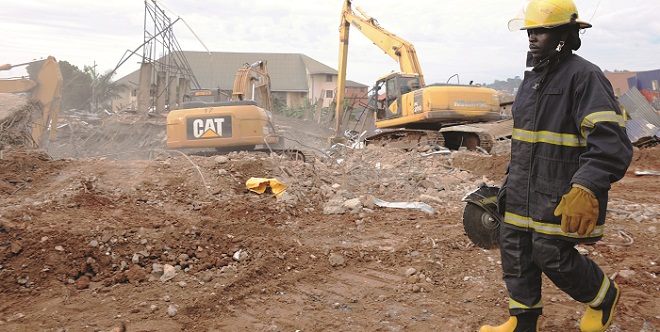
When an eight storey building in Kampala city collapsed on April 11 leaving four dead and others injured, various theorists started casting blame. The police faulted owner of the building, Moses Kyaseka. He was accused of being negligent and failing to take action even when he saw cracks in the walls of the building that was partially occupied even though it was still under construction.
Then, Kampala City Council Authority (KCCA) announced that the contractor was operating without approval from them and the Uganda Society of Architects President, Richard Turyahabwe, issued a statement blaming KCCA’s predecessor for approving faulty plans in 2009.
Though planned to be eight floors, the building on a busy part of Sir Apollo Kagwa Road in the Makerere University area, had gone up to just four floors. But it already housed thriving business, including a boutique, pharmacy, restaurant and a garage among other shops. Meanwhile, construction was still on-going.
When the Independent visited the site three days after the tragedy, it was sealed off. Crowds of curious people occasionally gathered and emergency services had shifted from a search and rescue mode to a search for the dead that could still be trapped in the debris of broken concrete slabs, glass, and twisted steel rods. KCCA excavators were on site but not operating.
This is not the first time a major building is collapsing in Kampala. Most of the time, the experts blame the same culprits: shoddy construction methods, use of quack engineers, lack of supervision, and contractors constructing without permits. The media publish condemnatory stories but soon move on.
In 2015, two buildings one in Kansanga and another in Lungujja both Kampala city suburbs caved in leaving many injured and more than five dead.Just two years before in July 2013, Nice Times Building located in down town Kampala collapsed leaving about 10 people injured. In July 2012, a building under construction along Lugogo By-pass in Kampala collapsed killing two workers whereas the same month in 2011, dozens were injured when a building under construction in Ntinda broke down. The most famous collapse was in October 2008 when a wall around the Shs 120 billion National Social Security Fund (NSSF) construction site on Lumumba Avenue in Kampala caved in leaving atleast seven dead.
After each tragedy, debate rotates around shoddy work and questions such as what ought to be done, what should be in place for a building to be certified and what kind of supervision goes around these sites but they have not been fully answered.
Future tragedies can be avoided
A KCCA architect, Robert Kiggundu, told The Independent that they have an eight-step guide which everyone hoping to set up a structure in Kampala should follow if they are to avoid future tragedies. He said the first thing they do when an individual tenders in their application is to approve ownership of the land before going to the next step of approving drawings of the structure made by an architect who puts into consideration the public health and environment issues outlined in the Public Health and Environment Act.
After handing in all the required paper work and paying an assessment fee to the authority which is Shs1000 per Sq meter for a bungalow, Shs30, 000 per suspended slab for a storey house and Shs100, 000 for a luxurious building, Kiggundu says the file is forwarded for technical review by a team comprising of a civil engineer, physical planner, environmental specialist, public health official and an architect. These are supposed to review the project and submit a report to the physical planning committee that eventually gives a contractor a go-ahead or any other recommendation.
“This committee sits every week to review 30 to 40 applications we receive per week. They are supposed to go to the site and inspect before giving the contractor a job card or permit to do work,” he says.
“The requirement is for a site to have a sign post giving a few details of contractor and construction. You are not supposed to start without this yellow card and this is binding to all these experts,” Kiggundu adds.
While many of these rules apply to storey house where a structural certificate is offered when a particular floor is completed, for bungalows they mainly consider the architectural work although for both structures, an occupation permit should be got when the building is completed.
 The Independent Uganda: You get the Truth we Pay the Price
The Independent Uganda: You get the Truth we Pay the Price


